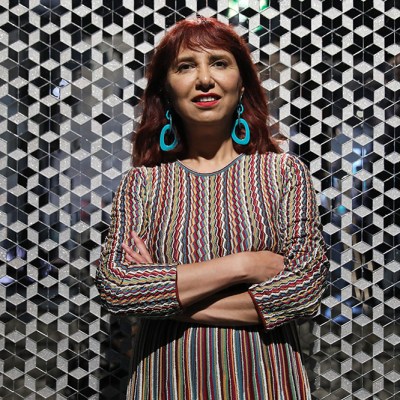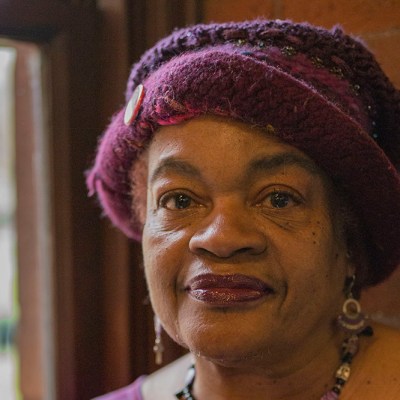Joël Andrianomearisoa considers his work to be a series of investigations into the complex emotional states that we all experience, but struggle to put into words. Informed by his Madagascan heritage, he draws on a wide range of cultural references to create artworks in mediums spanning sculpture, installation, textiles, drawing and text. He likes to work collaboratively and for his latest exhibition, ‘Our land just like a dream’ at the Museum of African Contemporary Art Al Maaden (MACAAL) in Marrakech, local craftspeople and contemporary artists helped him transform the space into an immersive installation. Andrianomearisoa is also the founder and artistic director of Hakanto Contemporary, a non-profit arts space for local artists in Antananarivo, Madagascar.
Where is your studio?
I have two studios, one in Antananarivo, Madagascar and one in Paris. Paris is maybe more like an office – it’s where we produce smaller pieces. Madagascar is where make the larger-scale works and focus more on textile production. I have a team of eight people altogether, two in Madagascar and six in Paris, but the team in Paris sometimes travels to the other studio.
What’s each space like?
They are both houses where I live and work. At the beginning in Paris, I was living and working in the same place, but now I live in a flat on the sixth floor and the studio is on the ground floor of the same building. It’s a real mix of everything: office, production, storage. I live in the same building as the studio Madagascar and as I said, it’s a bit more focused on textiles. It’s where we store a lot of materials and do sewing work. It’s a space of production and reflection. And even though I also live there, I don’t really mix work with my private life.
Installation view of ‘Joël Andrianomearisoa: Our land just like a dream’ at MACAAL. Photo: courtesy studio Joël Andrianomearisoa

Is that separation important for you?
When you’re an artist, I think your private life ends up entering your art and your art enters your private life – it’s almost inevitable. [The separation I’m talking about] is more in terms of temporality. For example, in the past, I would often continue working late into the night, but now I work until maybe 6 or 8pm, sometimes later, but when I’m done with something, I’m done with it. In terms of space and geography, however, everything is mixed up. My work is not autobiographical – it’s not about me – but I cannot separate myself completely.
How does drawing fit into your practice?
Drawing has always been part of my process of thinking and building something – and when I’m talking about drawing, it’s not just lines or images, it’s also words. Every process is different, but the drawings are always the beginning. For me, it’s a language, not just a medium. I always have notebooks and pieces of paper around me, but until three years ago, I didn’t show [the drawings] as artworks.
Andrianomearisoa working on drawings for his show at MACAAL in Marrakech. Photo: courtesy studio Joël Andrianomearisoa and Ayoub El Bardii

Do you pin up images of other artists’ work that inspires you?
Of course, but it’s not only work by other artists that inspires me. It could be food – right now, in front of me, there’s [a bowl of] pasta, orecchiette, which we also served at the opening of my exhibition in MACAAL. It could be fashion images, design, architecture, a book, the lyrics of a song. Yesterday, I was looking at embroideries by Louise Bourgeois because I’m working on some embroidery at the moment. I’m definitely not the most minimal person in the world. I like to be surrounded by a lot of different things because inspiration can come from anywhere – a fragrance, a flower, a cigarette.
Does your studio have a particular smell?
Well, I just had a cigarette and we all smoke in the studio so that’s a permanent smell. I don’t know whether this translates well to English, but in French we say, the smell of cold tobacco – I love that smell. Otherwise, it depends on the project we are working on. When we were working with Diptyque we had their perfume around all the time and we were working with a particular scent for one of the installations at MACAAL. Yesterday, we were scanning some flowers so [the studio] was filled with the scent of flowers.
Do you listen to anything while you’re working?
Yes, but not all of the time. Music can be an ambience – when we are building large-scale pieces, it creates a kind of rhythm. Some songs will be the inspiration for or mood of a particular work. We can be listening to some jazz by Nina Simone and then some very stupid French song; we could have classical music playing and then a very romantic Malagasy song. It is very varied.
Installation view of ‘Joël Andrianomearisoa: Our land just like a dream’ at MACAAL. Photo: courtesy studio Joël Andrianomearisoa

What are you reading at the moment?
I’m reading too many things! I have a pile of books in front of me right now, including a book about Malagasy painting from the 19th century, a book about wax from African prints in Benin and a book by Sophie Calle. But I also read fashion magazines, things about design, artist monographs – a big range.
What’s the strangest object in your studio?
I love whisky and I just received, as a gift, a type of whisky from Greece which is perhaps quite strange but other than that, I think I’m probably the strangest thing in the studio.
Which artistic tool could you least do without?
Paper, then textiles. Paper for my drawings and the construction of the work. I love the power of it as a material. You can do many things with paper: you can send a love letter, sign a contract, create a divorce, you can buy something with a paper.
Andrianomearisoa in a workshop in Marrakech. Photo: courtesy Joël Andrianomearisoa studio and Ayoub El Bardii

What do you wear in the studio?
I don’t wear anything specific. It’s more about the colour which, for me, is black. It goes back to the divide between studio life and private life: being in the studio is like being at home so what I wear depends on my mood.
Who’s the most interesting visitor you’ve had to your studio?
I can give you three answers. The first is my mother. It’s always interesting when she comes to the studio because she doesn’t really understand what we are doing – she will ask a lot of questions or not say anything at all. [My second answer is] the son of my friend because the vision of a child is interesting to me but I think the most interesting visitor was a dog – seeing how it moved through the space. It was sniffing around, trying to play with things and some things [in the studio] are very fragile so we had to think about that. All of these visits were with people – or animals – who are not connected to art. There have been famous people who have visited, but for me, these three have been the most special.
Is anything or anyone banned?
Everything is possible in the studio – it’s a place where you can do almost anything. Sometimes we invite a lot of people, we have parties, sometimes it’s full of flowers or textiles. It’s a place of experimentation so no, nothing is banned – except, perhaps, burning it down.
‘Joël Andrianomearisoa: Our land just like a dream’ is at MACAAL, Marrakech until 16 July 2023. His work is also included in the group exhibition ‘Labyrinth’ at Kristin Hjellegjerde Gallery, Wandsworth until 5 November.



